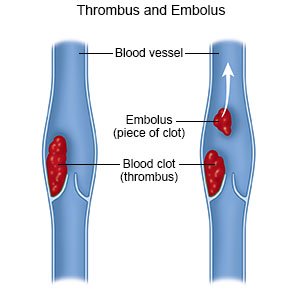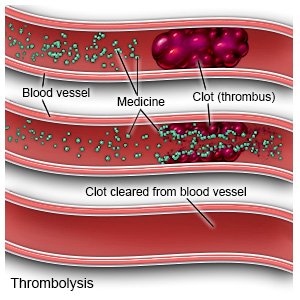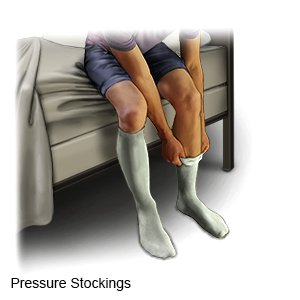Thrombolysis
Medically reviewed by Drugs.com. Last updated on Aug 4, 2025.
What do I need to know about thrombolysis?
Thrombolysis is a procedure to dissolve or break up a blood clot. A blood clot can block blood flow to areas of your body and become life-threatening. Thrombolysis can return blood flow and reduce harm to areas such as your brain, heart, or lungs.
 |
How do I prepare for the procedure?
- Your healthcare provider will tell you how to prepare. Your provider may tell you not to eat or drink anything after midnight on the day of your procedure. Arrange to have someone drive you home after you are discharged.
- Tell your provider about all your current medicines. Your provider will tell you if you need to stop any medicine for the procedure, and when to stop. Your provider will tell you which medicines to take or not take on the day of the procedure.
- You may be given contrast liquid before or during the procedure to help your provider see the clot better. Tell your provider if you have ever had an allergic reaction to contrast liquid.
Related medications
What will happen during the procedure?
- General anesthesia may be given to keep you asleep during the procedure.
- Your healthcare provider will inject medicine into your IV that will help dissolve or break up the clot. It is most commonly given into a vein, but it may be given into an artery. If the medicine is given into an artery, a catheter is guided by x-ray so it is near the blood clot.
- Your heart rate and blood pressure will be monitored. Healthcare providers may also check your neurological (neuro) status. Your neuro status is checked to see how well your brain is working. Healthcare providers may check your eyes, your memory, and your hand grasp.
 |
What should I expect after the procedure?
You will be monitored closely for any problems. Do not get out of bed until your healthcare provider says it is okay. You will then be able to go home or be taken to your hospital room.
- The catheter may be left in place if the medicine needs to continue to break up the clot. You will need to stay in the hospital if the catheter is left in place. Your provider will need to do the thrombolysis again to remove the rest of the clot. You will be told not to move your leg while the catheter is in place. Tell your provider if lying flat starts to cause back discomfort. If there is no bleeding, your provider may help you roll onto your side.
- You will need to wear a compression device after your procedure. Examples include pressure stockings or boots and sequential compression devices. These improve blood flow and help prevent clots.

- You will be helped to walk around after the procedure. Movement will help prevent blood clots. You may also be given exercises to do in bed. Do not get out of bed on your own until your provider says you can. Ask before you get up the first time. You may need help to stand up safely. When you are able to get up on your own, sit or lie down right away if you feel weak or dizzy. Then press the call button to let someone know you need help.
- Medicines:
- Anticoagulants are a type of blood thinner medicine that helps prevent clots. Anticoagulants may cause you to bleed or bruise more easily.
- Antiplatelets help prevent blood clots. This medicine makes it more likely for you to bleed or bruise.
What are the risks of thrombolysis?
Thrombolysis increases your risk for bleeding. You may have increased nosebleeds or bleeding from your gums. You may also have bleeding in your stomach or brain. Bleeding can become severe and life-threatening.
Care Agreement
You have the right to help plan your care. Learn about your health condition and how it may be treated. Discuss treatment options with your healthcare providers to decide what care you want to receive. You always have the right to refuse treatment. The above information is an educational aid only. It is not intended as medical advice for individual conditions or treatments. Talk to your doctor, nurse or pharmacist before following any medical regimen to see if it is safe and effective for you.© Copyright Merative 2025 Information is for End User's use only and may not be sold, redistributed or otherwise used for commercial purposes.
Learn more about Thrombolysis
Care guides
Further information
Always consult your healthcare provider to ensure the information displayed on this page applies to your personal circumstances.
